-
 Bitcoin
Bitcoin $105,278.9859
4.61% -
 Ethereum
Ethereum $2,414.7741
8.20% -
 Tether USDt
Tether USDt $1.0007
0.05% -
 XRP
XRP $2.1600
7.53% -
 BNB
BNB $639.5433
3.75% -
 Solana
Solana $144.3830
9.37% -
 USDC
USDC $1.0001
0.02% -
 TRON
TRON $0.2742
3.84% -
 Dogecoin
Dogecoin $0.1640
8.57% -
 Cardano
Cardano $0.5811
7.49% -
 Hyperliquid
Hyperliquid $37.2466
5.28% -
 Sui
Sui $2.8243
14.84% -
 Bitcoin Cash
Bitcoin Cash $460.8816
2.22% -
 Chainlink
Chainlink $12.9580
11.75% -
 UNUS SED LEO
UNUS SED LEO $9.1359
1.23% -
 Avalanche
Avalanche $18.2302
10.30% -
 Stellar
Stellar $0.2463
7.80% -
 Toncoin
Toncoin $2.9151
7.18% -
 Shiba Inu
Shiba Inu $0.0...01163
9.79% -
 Hedera
Hedera $0.1532
14.01% -
 Litecoin
Litecoin $85.3310
6.29% -
 Monero
Monero $308.8215
2.90% -
 Ethena USDe
Ethena USDe $1.0007
0.03% -
 Polkadot
Polkadot $3.4259
9.42% -
 Dai
Dai $1.0002
0.01% -
 Bitget Token
Bitget Token $4.1742
3.19% -
 Uniswap
Uniswap $6.8272
8.53% -
 Pepe
Pepe $0.0...09939
12.29% -
 Pi
Pi $0.5358
6.03% -
 Aave
Aave $257.3092
12.83%
Is WMA effective in the early stages of a trend? How to capture early signals?
WMA's responsiveness to recent price data makes it valuable for early trend detection in crypto trading, but traders should use additional tools to confirm signals and avoid false positives.
May 23, 2025 at 09:21 am
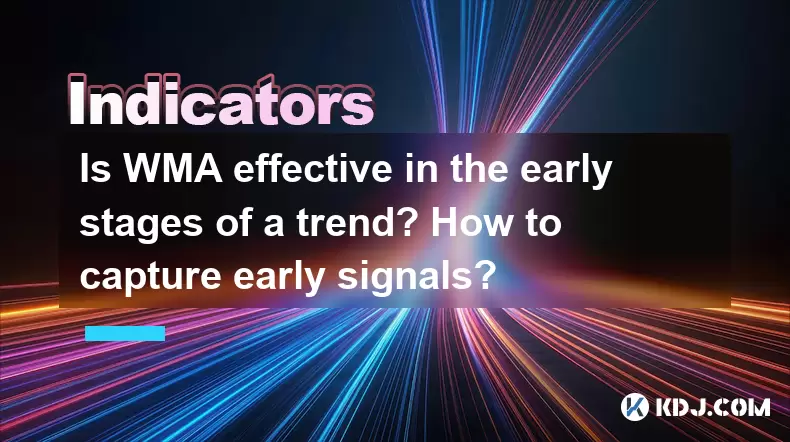
Understanding WMA and Its Application in Crypto Trading
In the world of cryptocurrency trading, the Weighted Moving Average (WMA) is a popular technical indicator used to identify trends and potential reversal points. The WMA gives more weight to recent price data, making it more responsive to new information than other moving averages like the Simple Moving Average (SMA). This responsiveness is particularly valuable in the volatile crypto market, where early detection of trends can lead to profitable trades. But the question arises: is WMA effective in the early stages of a trend?
Effectiveness of WMA in Early Trend Detection
The WMA's effectiveness in the early stages of a trend lies in its construction. By assigning higher weights to more recent prices, the WMA can signal a trend change more quickly than other moving averages. In the cryptocurrency market, where trends can develop and reverse rapidly, this characteristic of WMA can be advantageous. Traders often find that the WMA provides earlier signals than the SMA, which can be crucial for entering trades at the onset of a new trend.
How to Capture Early Signals Using WMA
To effectively use WMA for capturing early signals in the crypto market, traders should follow a systematic approach. Here's how you can set up and interpret WMA signals:
Choose the Right Period: The period of the WMA can significantly affect its sensitivity. A shorter period, such as 10 or 20 days, will make the WMA more responsive to price changes, potentially capturing early trends. A longer period, like 50 or 100 days, might be useful for identifying more established trends.
Monitor WMA Crossovers: One of the most common methods for capturing early signals is to watch for crossovers between the price and the WMA. When the price crosses above the WMA, it may indicate the start of an uptrend. Conversely, when the price falls below the WMA, it could signal the beginning of a downtrend.
Use Multiple WMAs: To increase the reliability of early signals, traders often use multiple WMAs with different periods. For example, a crossover between a short-term WMA (e.g., 10-day) and a longer-term WMA (e.g., 50-day) can provide a stronger indication of a new trend.
Combine with Other Indicators: While WMA can be effective, combining it with other technical indicators like the Relative Strength Index (RSI) or the Moving Average Convergence Divergence (MACD) can help confirm early signals and reduce false positives.
Practical Example of Using WMA for Early Trend Detection
Let's consider a practical example of using WMA to capture an early signal in the Bitcoin (BTC) market. Suppose you are monitoring the daily chart of BTC/USD and have applied a 20-day WMA and a 50-day WMA.
Observe the Price Action: You notice that the price of Bitcoin has been consolidating around the 20-day WMA for several days, but it has not yet crossed the 50-day WMA.
Identify the Crossover: One day, the price of Bitcoin breaks above the 20-day WMA and continues to rise, approaching the 50-day WMA. This could be an early signal of an uptrend.
Confirm with Other Indicators: To confirm this signal, you check the RSI, which shows that Bitcoin is not yet overbought. Additionally, the MACD line crosses above the signal line, further supporting the potential uptrend.
Enter the Trade: Based on these signals, you decide to enter a long position on Bitcoin, anticipating that the early signal detected by the WMA crossover will lead to further price increases.
Potential Challenges and Considerations
While the WMA can be effective in capturing early signals, traders should be aware of potential challenges and considerations:
False Signals: Due to its sensitivity, the WMA can sometimes generate false signals, especially in highly volatile markets. It's essential to use additional confirmation tools to filter out these false positives.
Whip Saws: Short-term WMAs are more prone to whip saws, where the price crosses the WMA multiple times in a short period, leading to confusion and potential losses.
Market Context: The effectiveness of WMA signals can vary depending on the overall market context. During periods of high volatility or significant news events, WMA signals may be less reliable.
Adjusting WMA Parameters for Different Cryptocurrencies
Different cryptocurrencies may require different WMA parameters due to varying levels of volatility and market dynamics. For instance:
Bitcoin (BTC): As the most liquid and widely traded cryptocurrency, Bitcoin might benefit from a slightly longer WMA period (e.g., 20-50 days) to filter out noise and capture more significant trends.
Altcoins: For less liquid and more volatile altcoins, a shorter WMA period (e.g., 10-20 days) might be more appropriate to capture early trends amidst the increased price fluctuations.
Stablecoins: Stablecoins, which are designed to maintain a stable value, might not require the use of WMA for trend detection, as they typically exhibit less price movement.
FAQs
Q: Can WMA be used effectively on all timeframes?
A: While WMA can be used on various timeframes, its effectiveness may vary. On shorter timeframes like 1-minute or 5-minute charts, the WMA might generate too many false signals due to increased volatility. On longer timeframes like daily or weekly charts, WMA signals tend to be more reliable but may come later in the trend.
Q: How can I differentiate between a genuine early signal and a false positive using WMA?
A: To differentiate between genuine early signals and false positives, consider using additional confirmation tools like volume analysis, other technical indicators (e.g., RSI, MACD), and fundamental analysis. If multiple indicators align with the WMA signal, it increases the likelihood of a genuine trend.
Q: Is it possible to use WMA for both short-term and long-term trading strategies?
A: Yes, WMA can be adapted for both short-term and long-term trading strategies by adjusting the period length. For short-term trading, use a shorter period WMA (e.g., 5-10 days) to capture quick price movements. For long-term trading, a longer period WMA (e.g., 50-200 days) can help identify more sustained trends.
Q: How does WMA compare to other moving averages like EMA in terms of early trend detection?
A: Both WMA and Exponential Moving Average (EMA) give more weight to recent prices, making them more responsive than SMA. However, WMA assigns weights linearly, while EMA uses an exponential decay. In practice, WMA might be slightly less responsive than EMA but can still provide effective early signals, especially in the crypto market's unique environment.
Disclaimer:info@kdj.com
The information provided is not trading advice. kdj.com does not assume any responsibility for any investments made based on the information provided in this article. Cryptocurrencies are highly volatile and it is highly recommended that you invest with caution after thorough research!
If you believe that the content used on this website infringes your copyright, please contact us immediately (info@kdj.com) and we will delete it promptly.
- Little Pepe: The Next Ethereum 9000% Token Pump?
- 2025-06-24 18:45:12
- Bitcoin Holdings Strategy: Riding the $BTC Wave Like a Wall Street Pro
- 2025-06-24 18:25:12
- Mastercard, Fiserv, and Stablecoin Adoption: A New Era for Payments?
- 2025-06-24 19:05:12
- Mastercard, USDG Stablecoin, and Fiserv: Revolutionizing Payments or Just Another Fad?
- 2025-06-24 18:45:12
- XRP Price Surges Amid Market Tensions: A Token Rally to Watch
- 2025-06-24 19:26:05
- Middle East, Financial Safety, and International Crisis: Navigating the Volatility
- 2025-06-24 19:10:12
Related knowledge
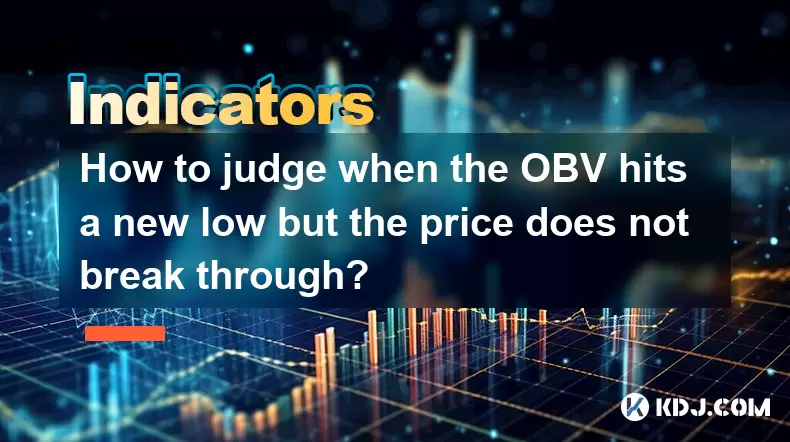
How to judge when the OBV hits a new low but the price does not break through?
Jun 24,2025 at 07:56pm
Understanding the Basics of OBV and Price ActionOn-Balance Volume (OBV) is a momentum indicator that uses volume flow to predict changes in stock or cryptocurrency prices. The core principle behind OBV is that volume often precedes price movement. When OBV hits a new low, but the price does not break through its previous support level, this can indicate...
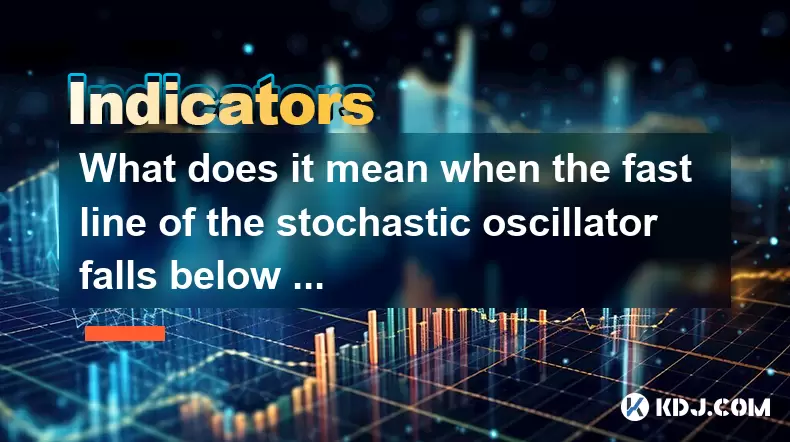
What does it mean when the fast line of the stochastic oscillator falls below the slow line?
Jun 24,2025 at 07:07pm
Understanding the Stochastic OscillatorThe stochastic oscillator is a momentum indicator used in technical analysis to assess overbought or oversold conditions in financial markets, including cryptocurrencies. It consists of two lines: the fast line (typically %K) and the slow line (typically %D). The fast line represents the current closing price relat...
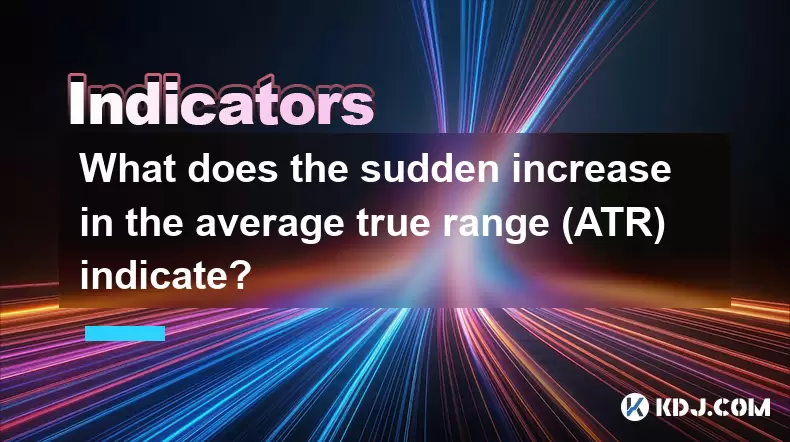
What does the sudden increase in the average true range (ATR) indicate?
Jun 24,2025 at 06:42pm
Understanding the Average True Range (ATR) in Cryptocurrency TradingThe Average True Range (ATR) is a technical indicator used by traders to measure market volatility. In the context of cryptocurrency, where prices can swing dramatically within short periods, ATR becomes an essential tool for assessing potential price movements. The ATR does not indicat...
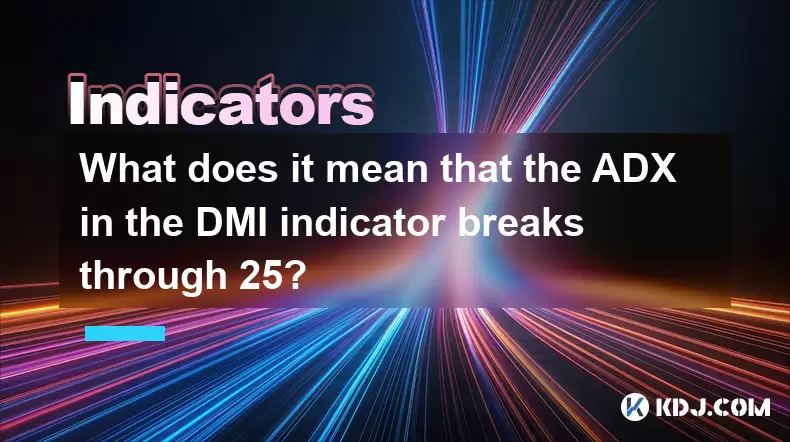
What does it mean that the ADX in the DMI indicator breaks through 25?
Jun 24,2025 at 06:21pm
Understanding the DMI Indicator and Its ComponentsThe Directional Movement Index (DMI) is a technical analysis tool used to identify the strength and direction of a trend in cryptocurrency markets. The indicator consists of two primary lines: the Positive Directional Indicator (+DI) and the Negative Directional Indicator (-DI). These lines help traders ...
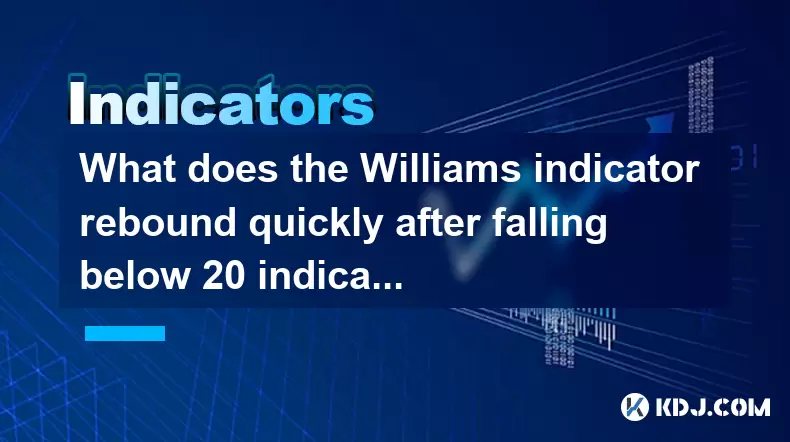
What does the Williams indicator rebound quickly after falling below 20 indicate?
Jun 24,2025 at 04:49pm
Understanding the Williams %R IndicatorThe Williams %R indicator, also known as Williams Percent Range, is a momentum oscillator used in technical analysis to identify overbought and oversold conditions in financial markets, including cryptocurrencies. It was developed by Larry Williams and typically operates on a scale from 0 to -100. In the context of...
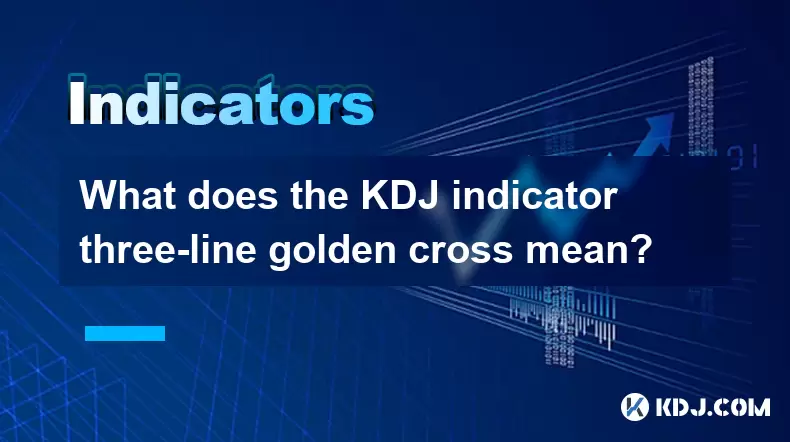
What does the KDJ indicator three-line golden cross mean?
Jun 24,2025 at 05:28pm
Understanding the KDJ Indicator in Cryptocurrency TradingThe KDJ indicator is a technical analysis tool widely used in cryptocurrency trading to identify potential buy and sell signals. It combines elements of two other indicators: the Stochastic Oscillator and the J line, which acts as a signal line. The KDJ consists of three lines — K, D, and J — each...

How to judge when the OBV hits a new low but the price does not break through?
Jun 24,2025 at 07:56pm
Understanding the Basics of OBV and Price ActionOn-Balance Volume (OBV) is a momentum indicator that uses volume flow to predict changes in stock or cryptocurrency prices. The core principle behind OBV is that volume often precedes price movement. When OBV hits a new low, but the price does not break through its previous support level, this can indicate...

What does it mean when the fast line of the stochastic oscillator falls below the slow line?
Jun 24,2025 at 07:07pm
Understanding the Stochastic OscillatorThe stochastic oscillator is a momentum indicator used in technical analysis to assess overbought or oversold conditions in financial markets, including cryptocurrencies. It consists of two lines: the fast line (typically %K) and the slow line (typically %D). The fast line represents the current closing price relat...

What does the sudden increase in the average true range (ATR) indicate?
Jun 24,2025 at 06:42pm
Understanding the Average True Range (ATR) in Cryptocurrency TradingThe Average True Range (ATR) is a technical indicator used by traders to measure market volatility. In the context of cryptocurrency, where prices can swing dramatically within short periods, ATR becomes an essential tool for assessing potential price movements. The ATR does not indicat...

What does it mean that the ADX in the DMI indicator breaks through 25?
Jun 24,2025 at 06:21pm
Understanding the DMI Indicator and Its ComponentsThe Directional Movement Index (DMI) is a technical analysis tool used to identify the strength and direction of a trend in cryptocurrency markets. The indicator consists of two primary lines: the Positive Directional Indicator (+DI) and the Negative Directional Indicator (-DI). These lines help traders ...

What does the Williams indicator rebound quickly after falling below 20 indicate?
Jun 24,2025 at 04:49pm
Understanding the Williams %R IndicatorThe Williams %R indicator, also known as Williams Percent Range, is a momentum oscillator used in technical analysis to identify overbought and oversold conditions in financial markets, including cryptocurrencies. It was developed by Larry Williams and typically operates on a scale from 0 to -100. In the context of...

What does the KDJ indicator three-line golden cross mean?
Jun 24,2025 at 05:28pm
Understanding the KDJ Indicator in Cryptocurrency TradingThe KDJ indicator is a technical analysis tool widely used in cryptocurrency trading to identify potential buy and sell signals. It combines elements of two other indicators: the Stochastic Oscillator and the J line, which acts as a signal line. The KDJ consists of three lines — K, D, and J — each...
See all articles
























































































